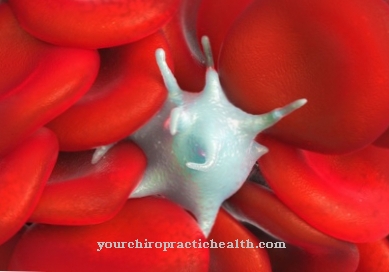The Blood contact time is the time in which blood circulates in the small blood vessels in the lungs and in which the diffusion of breathing gases takes place. Therefore, the blood contact time has an important influence on the oxygen content in the blood.
What is the blood contact time?

The blood contact time describes the period of time that the blood spends in the alveoli of the lungs. Gas exchange takes place in the alveoli of the lungs, which means that the red blood cells (erythrocytes) release carbon dioxide and absorb oxygen.
The carbon dioxide-rich air is then exhaled. The blood contact time depends on several factors such as cardiac output, blood pressure and flow resistance.
Function & task
The gas exchange in the alveoli is influenced by both the ventilation of the lungs and their blood flow. There are two aspects to consider. On the one hand, hemodynamics play a role and, on the other hand, the gas exchange between the alveoli and the small blood vessels that surround the alveoli (alveolar capillaries). There are some interrelationships between hemodynamics, diffusion and gas exchange that affect blood contact time.
Cardiac output, flow resistance in the vessels and blood pressure play an important role in hemodynamics. The size of the contact surface between the alveoli and the blood is important for the diffusion of breathing gases. The flow rate of the blood in the capillaries also has a positive or negative effect and is, among other things, influenced by vasodilatation and constriction.
The blood contact time is of decisive importance for balancing the respiratory gases, i.e. the exchange of carbon dioxide for oxygen, because only here does the blood come into contact with the air in the alveoli and transmission is possible.
Medic Roughton found that a normal blood contact time is around 0.7-0.8 seconds. Up to a blood contact time of 0.35 seconds, an almost physiological balance can still take place between the air in the alveoli and the blood. The required blood contact time, however, also depends on the oxygen saturation of the venous blood. If the blood is very low in oxygen and rich in carbon dioxide, it is possible that adequate oxygen equilibrium cannot take place within the normal blood contact time.
Since the blood passes the capillaries of the lungs faster with an increase in the cardiac output, there should actually be an oxygen deficiency. However, the body is very adaptable, so that the cardiac output can even be increased tenfold during exercise without causing oxygen undersaturation. The reason for this is presumably so-called reserve capillaries, which can be opened when the demand for oxygen increases.
According to some authors, only 60 to 75 percent of all alveoli are ventilated and supplied with blood at rest. This also helps ensure that the blood pressure in the lungs does not increase dramatically during exercise. The blood contact time thus remains almost constant.
You can find your medication here
➔ Medicines for shortness of breath and lung problemsIllnesses & ailments
Both too long and too short a blood contact time can cause discomfort. Too long a blood contact time results from a congestion of blood in the lungs. This can be caused by various factors. One possible cause is left heart failure. In left heart failure, the left heart is no longer able to circulate the blood that reaches the left heart from the right heart via the lungs. There is a backlog in the lungs. In the process, fluid flows from the blood into the alveoli. One speaks here of pulmonary edema. Gas exchange is no longer possible in the affected lung sections.
Shortened blood contact times are mostly caused by lung diseases. In emphysema, the air content in the lungs is abnormally increased. This increase is accompanied by a destruction of the lung tissue. The blood vessels in the lungs are also damaged. This reduces the blood contact time. The most common cause of emphysema is smoking. Passive smoking also poses a risk. Typical symptoms of emphysema include shortness of breath and blue skin (cyanosis). In addition, a barrel chest can develop.
The blood contact time is also shortened in the context of fibrosis. Pulmonary fibrosis is a chronic lung disease in which the functional tissue of the lungs is converted into connective tissue. These remodeling processes are initiated by chronic inflammatory processes in the lungs. Possible causes for this are infections, fine dust, gases, vapors, hairspray, smoking, drugs, herbicides and systemic diseases such as sarcoid or chronic polyarthritis. As with emphysema, the shortened blood contact time causes shortness of breath in fibrosis. In the early stages, this only occurs during exercise. Later, however, those affected suffer from it even at rest. Breathing is quick and shallow. There may also be a dry, tickly cough.
In the advanced stage, the symptoms of insufficient oxygen supply dominate. These include cyanosis, drumstick fingers, and watch glass nails. Due to the connective tissue remodeling, blood congestion sometimes occurs. This puts a strain on the heart. One speaks here of a cor pulmonale. In the advanced stage, there is a respiratory failure.
The heart can also cause a shorter blood contact time. The cause is then right heart failure. With right heart failure, the right heart can no longer transport enough blood to the pulmonary vessels. The cardiac output drops. Right heart failure can result from heart valve defects, for example. Typically, cyanosis occurs due to the lack of oxygen. Other backflow symptoms are edema, ascites and enlarged liver (hepatomegaly) and spleen (splenomegaly). In addition, there may be increased urination at night and an enlarged heart.













.jpg)

.jpg)
.jpg)











.jpg)